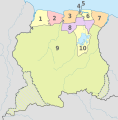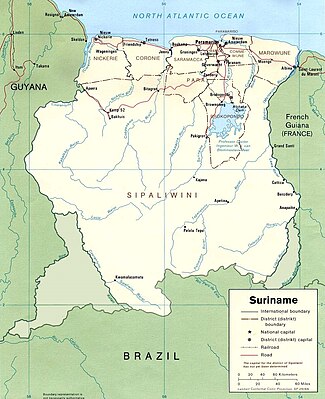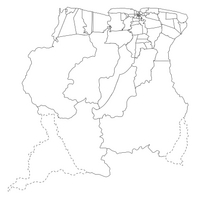
Back بوابة:سورينام Arabic Portal:Surinam Spanish Portail:Suriname French Portal:Suriname Malay Portaal:Suriname Dutch Portal:Suriname Portuguese Портал:Суринам Russian باب:سرینام Urdu Portal:苏里南 Chinese
The Suriname portal
Suriname (/ˈsʊərɪnæm, -nɑːm/ SOOR-ih-NAM, -NAHM, Dutch: [syːriˈnaːmə] ), officially the Republic of Suriname (Dutch: Republiek Suriname [reːpyˌblik ˌsyːriˈnaːmə]), is a country in northern South America, sometimes considered part of the Caribbean and the West Indies. Situated slightly north of the equator, over 90% of its territory is covered by rainforests, the highest proportion of forest cover in the world. Suriname is bordered by the Atlantic Ocean to the north, French Guiana to the east, Guyana to the west, and Brazil to the south. It is the smallest country in South America by both population and territory, with around 612,985 inhabitants in an area of approximately 163,820 square kilometers (63,251 square miles).0 The capital and largest city is Paramaribo, which is home to roughly half the population. Suriname was inhabited as early as the fourth millennium BC by various indigenous peoples, including the Arawaks, Caribs, and Wayana. Europeans arrived in the 16th century, with the Dutch establishing control over much of the country's current territory by the late 17th century. During the Dutch colonial period, Suriname was a lucrative source of sugar. Its plantation economy was initially driven by African slave labour; with the abolition of slavery in 1863, indentured servants were brought from Asia, predominantly from British India and the Dutch East Indies. In 1954, Suriname became a constituent country of the Kingdom of the Netherlands. On 25 November 1975, it became independent following negotiations with the Dutch government. Suriname continues to maintain close diplomatic, economic, and cultural ties with the Netherlands. Suriname's culture and society strongly reflect the legacy of Dutch colonial rule. It is the only sovereign nation outside Europe where Dutch is the official and prevailing language of government, business, media, and education. An estimated 60% of the population speaks Dutch as a native language. Sranan Tongo, an English-based creole language, is a widely used lingua franca. Most Surinamese are descendants of slaves and labourers brought from Africa and Asia by the Dutch. Suriname is highly diverse, with no ethnic group forming a majority; proportionally, its Muslim and Hindu populations are some of the largest in the Americas. Most people live along the northern coast, centered around Paramaribo, making Suriname one of the least densely populated countries on Earth. Suriname is a developing country with a medium level of human development; its economy is heavily dependent on its abundant natural resources, namely bauxite, gold, petroleum, and agricultural products. Suriname is a member of the Caribbean Community (CARICOM), the United Nations, and the Organisation of Islamic Cooperation. (Full article...) Selected article -Lesbian, gay, bisexual, and transgender (LGBT) people in Suriname may face legal challenges not experienced by non-LGBT residents. Both male and female expressions of same-sex sexual activity are legal in Suriname. Since 2015, hate speech and discrimination in employment and the provision of goods and services on the basis of sexual orientation has been banned in the country. Same-sex marriage and civil unions are not recognised by law. Nevertheless, Suriname is legally bound to the January 2018 Inter-American Court of Human Rights ruling, which held that same-sex marriage is a human right protected by the American Convention on Human Rights. While homosexuality tends to be viewed as a taboo topic, the situation and attitudes have slowly changed in recent years. (Full article...)General imagesThe following are images from various Suriname-related articles on Wikipedia.
Selected biography -
Henck Alphonsus Eugène Arron (25 April 1936 – 4 December 2000) was a Surinamese politician who served as the first Prime Minister of Suriname after it gained independence in 1975. A member of the National Party of Suriname, he served from 24 December 1973 with the transition government, to 25 February 1980. He was overthrown in a coup d'état by the military, led by Dési Bouterse. Released in 1981 after charges of corruption were dropped, he returned to banking, his previous career. In 1987, Arron was elected as Vice President of Suriname and served until another coup in 1990 overthrew the government. (Full article...)
Selected picture The street Waterkant in Paramaribo
MapTopics
CategoriesRelated portalsThings to do
WikimediaThe following Wikimedia Foundation sister projects provide more on this subject:
SourcesDiscover Wikipedia using portals | ||||||||||||||||||||||||||||||||||||||||||||||||||||||||||||||||
© MMXXIII Rich X Search. We shall prevail. All rights reserved. Rich X Search





























































































